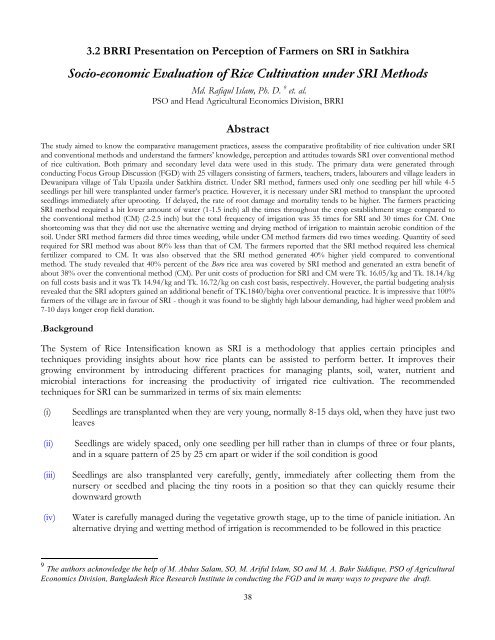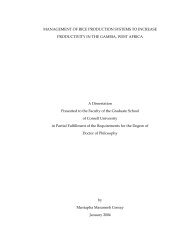Revised proceedings - The System of Rice Intensification - Cornell ...
Revised proceedings - The System of Rice Intensification - Cornell ...
Revised proceedings - The System of Rice Intensification - Cornell ...
Create successful ePaper yourself
Turn your PDF publications into a flip-book with our unique Google optimized e-Paper software.
3.2 BRRI Presentation on Perception <strong>of</strong> Farmers on SRI in Satkhira<br />
Socio-economic Evaluation <strong>of</strong> <strong>Rice</strong> Cultivation under SRI Methods<br />
Md. Rafiqul Islam, Ph. D. 9 et. al.<br />
PSO and Head Agricultural Economics Division, BRRI<br />
Abstract<br />
<strong>The</strong> study aimed to know the comparative management practices, assess the comparative pr<strong>of</strong>itability <strong>of</strong> rice cultivation under SRI<br />
and conventional methods and understand the farmers‟ knowledge, perception and attitudes towards SRI over conventional method<br />
<strong>of</strong> rice cultivation. Both primary and secondary level data were used in this study. <strong>The</strong> primary data were generated through<br />
conducting Focus Group Discussion (FGD) with 25 villagers consisting <strong>of</strong> farmers, teachers, traders, labourers and village leaders in<br />
Dewanipara village <strong>of</strong> Tala Upazila under Satkhira district. Under SRI method, farmers used only one seedling per hill while 4-5<br />
seedlings per hill were transplanted under farmer‟s practice. However, it is necessary under SRI method to transplant the uprooted<br />
seedlings immediately after uprooting. If delayed, the rate <strong>of</strong> root damage and mortality tends to be higher. <strong>The</strong> farmers practicing<br />
SRI method required a bit lower amount <strong>of</strong> water (1-1.5 inch) all the times throughout the crop establishment stage compared to<br />
the conventional method (CM) (2-2.5 inch) but the total frequency <strong>of</strong> irrigation was 35 times for SRI and 30 times for CM. One<br />
shortcoming was that they did not use the alternative wetting and drying method <strong>of</strong> irrigation to maintain aerobic condition <strong>of</strong> the<br />
soil. Under SRI method farmers did three times weeding, while under CM method farmers did two times weeding. Quantity <strong>of</strong> seed<br />
required for SRI method was about 80% less than that <strong>of</strong> CM. <strong>The</strong> farmers reported that the SRI method required less chemical<br />
fertilizer compared to CM. It was also observed that the SRI method generated 40% higher yield compared to conventional<br />
method. <strong>The</strong> study revealed that 40% percent <strong>of</strong> the Boro rice area was covered by SRI method and generated an extra benefit <strong>of</strong><br />
about 38% over the conventional method (CM). Per unit costs <strong>of</strong> production for SRI and CM were Tk. 16.05/kg and Tk. 18.14/kg<br />
on full costs basis and it was Tk 14.94/kg and Tk. 16.72/kg on cash cost basis, respectively. However, the partial budgeting analysis<br />
revealed that the SRI adopters gained an additional benefit <strong>of</strong> TK.1840/bigha over conventional practice. It is impressive that 100%<br />
farmers <strong>of</strong> the village are in favour <strong>of</strong> SRI - though it was found to be slightly high labour demanding, had higher weed problem and<br />
7-10 days longer crop field duration.<br />
.Background<br />
<strong>The</strong> <strong>System</strong> <strong>of</strong> <strong>Rice</strong> <strong>Intensification</strong> known as SRI is a methodology that applies certain principles and<br />
techniques providing insights about how rice plants can be assisted to perform better. It improves their<br />
growing environment by introducing different practices for managing plants, soil, water, nutrient and<br />
microbial interactions for increasing the productivity <strong>of</strong> irrigated rice cultivation. <strong>The</strong> recommended<br />
techniques for SRI can be summarized in terms <strong>of</strong> six main elements:<br />
(i) Seedlings are transplanted when they are very young, normally 8-15 days old, when they have just two<br />
leaves<br />
(ii) Seedlings are widely spaced, only one seedling per hill rather than in clumps <strong>of</strong> three or four plants,<br />
and in a square pattern <strong>of</strong> 25 by 25 cm apart or wider if the soil condition is good<br />
(iii) Seedlings are also transplanted very carefully, gently, immediately after collecting them from the<br />
nursery or seedbed and placing the tiny roots in a position so that they can quickly resume their<br />
downward growth<br />
(iv) Water is carefully managed during the vegetative growth stage, up to the time <strong>of</strong> panicle initiation. An<br />
alternative drying and wetting method <strong>of</strong> irrigation is recommended to be followed in this practice<br />
9 <strong>The</strong> authors acknowledge the help <strong>of</strong> M. Abdus Salam, SO, M. Ariful Islam, SO and M. A. Bakr Siddique, PSO <strong>of</strong> Agricultural<br />
Economics Division, Bangladesh <strong>Rice</strong> Research Institute in conducting the FGD and in many ways to prepare the draft.<br />
38

















